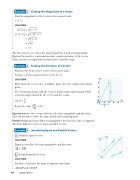Page 853 - Algebra 1
P. 853
Finding the Magnitude of a Vector
Find the magnitude of the vector to the nearest tenth. 〈-3, 5〉
SOLUTION
22 ⎪ 〈 a , b 〉 ⎥ = √ a + b
⎪〈-3, 5〉⎥ = √(-3)2 + 52
= √9 + 2 5 = √ 3 4
≈ 5.8
The direction of a vector is the angle formed by it and a horizontal line. Begin at the positive x-axis and measure counterclockwise to the vector. Then, use inverse trigonometric functions to find the angle.
Finding the Direction of a Vector
Find the direction of the vector to the nearest degree.
A boat’s velocity is given by the vector 〈4, 8〉.
SOLUTION
First, draw the vector on a coordinate plane. Use the origin as the initial point.
The horizontal change and the vertical change make right triangle FGH. ∠G is the angle formed by the vector and the x-axis.
t a n G = _8 . 4
8
6
4
2
O O
G 2 4 6 8 4
Example
2
Example
3
y
F
8
H
x
-1 _8
(4)≈ 63°.
So m∠G = tan
Equal vectors are two vectors that have the same magnitude and direction.
They do not have to have the same initial and terminal points.
Parallel vectors may have different magnitudes, but have the same or opposite direction. Equal vectors are always parallel vectors.
Identifying Equal and Parallel Vectors
a. Identify equal vectors.
SOLUTION
Equal vectors have the same magnitude and direction. A B = G H
b. Identify parallel vectors.
SOLUTION
Parallel vectors have the same or opposite directions. AB∥GH and CD∥EF
Example
4
B
F
A
D
C
H
E
G
838
Saxon Algebra 1


